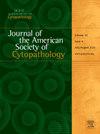通过横滨系统报告乳腺细针穿刺细胞病理学的非典型类别恶性肿瘤的临床放射学预测因子。
Q2 Medicine
Journal of the American Society of Cytopathology
Pub Date : 2025-01-30
DOI:10.1016/j.jasc.2025.01.006
引用次数: 0
摘要
简介:横滨系统的非典型分类(AC)是一个不确定的组,其特点是病变的细胞形态以良性为主,在乳腺细针穿刺中可能出现一些不常见的恶性特征。恶性肿瘤(ROM)的风险从13%到25%不等。其治疗取决于临床和放射学表现。由于大多数病例是良性的,选择病例进行进一步治疗可能对患者有益。本研究旨在确定AC乳腺细胞学中恶性肿瘤的临床放射学预测因子。材料和方法:选取清迈大学医院2015 - 2019年所有AC乳房细针穿刺病例,从电子数据库中进行细胞组织学相关性和ROM计算。采用多变量logistic回归对ROM计算的临床放射学因素进行恶性预测和筛查评分分析。结果:共抽取218例患者,年龄15 ~ 77岁。病灶大小0.2 ~ 9.2 cm。ROM为27.5%。年龄≥40岁(P = 0.03)、病变大小≥1 cm (P结论:AC的诊断有良、恶性之分。年龄≥40岁,病变大小≥1cm,可疑钙化/乳腺影像学报告和数据系统5是恶性肿瘤的有用预测因素。根据筛查分数选择病例可减少高达43.1%的侵入性手术。本文章由计算机程序翻译,如有差异,请以英文原文为准。
Clinicoradiological Predictors of Malignancy in the Atypical Category by the Yokohama System for Reporting Breast Fine-Needle Aspiration Cytopathology
Introduction
The atypical category (AC) by the Yokohama system is an indeterminate group characterized by predominantly benign cytomorphology of the lesions, with some uncommon features that may be seen in malignancy in breast fine-needle aspiration. The risk of malignancy (ROM) varies from 13% to 25%. Its management depends on the clinical and radiological findings. Since most cases are benign, selecting cases for further management may benefit patients. This study aims to determine the clinicoradiological predictors for malignancy in AC breast cytology.
Materials and Methods
All AC breast fine-needle aspirations at Chiang Mai University Hospital from 2015 to 2019 were selected from an electronic database for cyto-histological correlation and ROM calculation. The clinicoradiological factors calculated by ROM were analyzed using multivariable logistic regression for malignant prediction and screening scores.
Results
There were 218 aspirates from patients aged 15-77 years. The lesion size ranged from 0.2 to 9.2 cm. The ROM was 27.5%. The significant predictors were age ≥40 years (P = 0.03), lesion size ≥1 cm (P< 0.01), and suspicious calcification on imaging (P < 0.01). The ROM was numerically increased in Breast Imaging-Reporting and Data System 5. The screening score showed 88.3% sensitivity, 55.1% specificity, 42.7% positive predictive value, and 92.6% negative predictive value.
Conclusions
The AC diagnosis varies from benign to malignant. Age ≥40 years, a lesion size ≥1 cm, and suspicious calcification/Breast Imaging-Reporting and Data System 5 are useful predictors of malignancy. Selecting cases according to screening scores can reduce invasive procedures by up to 43.1%.
求助全文
通过发布文献求助,成功后即可免费获取论文全文。
去求助
来源期刊

Journal of the American Society of Cytopathology
Medicine-Pathology and Forensic Medicine
CiteScore
4.30
自引率
0.00%
发文量
226
审稿时长
40 days
 求助内容:
求助内容: 应助结果提醒方式:
应助结果提醒方式:


